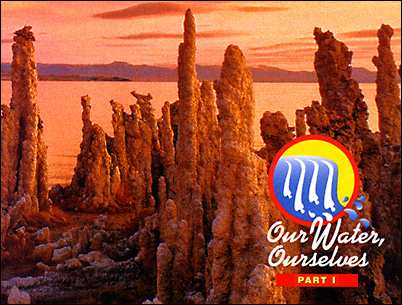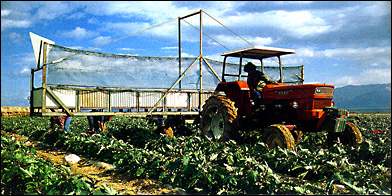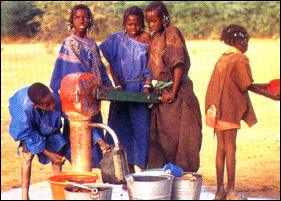Water, Water Everywhere
Innovation and Cooperation are Helping Slake the World’s Growing Thirst
“There it is. Take it,” city water superintendent William Mulholland told thousands of Los Angelenos who stood by in 1913 with tin cups in hand, waiting to taste the first water sluicing through the 223-mile aqueduct from the Owens Valley. In a water grab made famous by Roman Polanski’s movie Chinatown, a powerful group of L.A. businessmen stole water from the fruit growers and cattle ranchers of the Owens Valley and made a fortune building subdivisions and the most productive croplands in the world on the newly irrigated land.
Mulholland’s bounteous gesture pretty much sums up how we’ve felt about water from the start. Like the wealthy L.A. syndicate, we’ve taken it almost for free. We’ve used the gift of fresh water to irrigate our fields, producing a windfall harvest on thousands of acres of land where it would never have been possible on rainwater alone. In the northern hemisphere, we’ve harnessed and tamed three-quarters of the flow from the world’s major rivers to quench our thirst and generate power for our cities.
 1993 Allen Russell / Index Stock Photography
1993 Allen Russell / Index Stock Photography
It’s no wonder we behave like our cup runneth over: The planet has been blessed with more freshwater than we could ever possibly need. But because this abundant resource is distributed unevenly on the planet, we are starting to run up against the limits of available freshwater in many parts of the globe. According to a recent United Nations report, one-sixth of the world’s population—one billion people—lack access to clean water, and that number is expected to double in the next 30 years.
“A number of areas could enter a period of chronic shortages during this decade, including much of Africa, northern China, pockets of India, Mexico, the Middle East and parts of western North America,” according to Sandra Postel, director of the Global Water Policy Project in Amherst, Massachusetts. Some 26 countries are now considered to be “water scarce”—with fewer than 1,000 cubic meters of water available to each person per year. The number of water-scarce countries is expected to rise to 35 by the year 2020.
Signs of water scarcity are showing up in many parts of the world. According to the Worldwatch Institute, groundwater overpumping and aquifer depletion are now a serious problem in the world’s most intensive agricultural areas, including the western United States, India, and northern China. In many huge cities such as Mexico City, Bangkok and Jakarta, land is sinking as more groundwater is withdrawn to serve the water needs of growing populations than can’t be replenished by rainfall. “The Nile in Egypt, the Ganges in South Asia, the Yellow River in China and the Colorado River in North America are among the major rivers that are so dammed, diverted or overtapped that little or no fresh water reaches its final destination for significant stretches of time,” writes Postel.
In the century that’s now drawing to a close, demand for fresh water has grown twice as fast as population growth—due in large part to the Green Revolution in agriculture and a rising standard of living for many of the world’s people. Growing demand—coupled with centuries of poor water management and water pollution, which renders available resources unusable—has created local shortages of this renewable
but finite resource. Ideas like towing icebergs to the Middle East and piping Alaska river water under the ocean to thirsty California aside, most cost-effective sources of new water “development” have already been tapped. Competition is heating up between countries, between different users within an area, and between man and nature. Will we pursue available solutions through conservation and equitable reallocation? Or will Mark Twain be proved right when he said, “Whiskey’s for drinking. Water’s for fighting”?
Sharing The Wealth
A drive through Israel and the West Bank reveals two very different scenarios of our relationship with water in the coming half century. In Israel, you can see evidence of man’s ingenuity with living in a brutally parched landscape. Rows of orange trees and vegetable plants are irrigated with recycled wastewater from the cities. Seawater irrigates varieties of cotton and tomato plants that thrive on salty water. Most impressive, Israeli officials, while proud of their country’s success at realizing the Zionist dream of making the desert bloom, recognize that it’s unsustainable in the long run. They reportedly plan to transfer more than a third of agriculture’s freshwater to cities, using income from the growing industrial sector to import more of the nation’s food.
But 50 miles away in the West Bank, a different picture emerges. Many Palestinians lack running water, so they have to buy their water from trucks or capture in cisterns the little rainwater that falls. Although they are sitting on top of the West Bank aquifer, which supplies 25 percent of Israel’s water, they are forbidden by Israeli authorities to drill wells to tap the aquifer. Policymakers are starting to talk about water replacing oil as a major cause of war in the coming decades, and the Middle East, where such water-sharing tensions abound, is considered a hot spot for such conflicts.
 Shehzad Noorani / Peter Arnold Inc.
Shehzad Noorani / Peter Arnold Inc.
Competition between countries is becoming a common scenario in water-scarce regions all over the world. Egypt, nearly totally dependent on the Nile River, watches warily as Ethiopia builds hundreds of small dams on the river’s upper reaches and may soon proceed with plans to construct a major dam. Syria and Iraq fear their future water supplies will be threatened by Turkey’s construction of the massive Southwest Anatolia Project upstream on the Euphrates. Last year Botswana raised a public outcry when Namibia, Africa’s driest nation, announced emergency plans to divert water from the Okavango River to relieve drought conditions. Botswana was concerned that the diversion could hurt its number-one tourist attraction, the Okavango Delta, which draws top-dollar travelers to see some of the best wildlife viewing in Africa. The potential for conflict in many regions is so serious that the United Nations Commission on Sustainable Development dedicated its annual meeting this year to discussions of how to avoid a freshwater crisis.
However, there are signs that nations are willing to cooperate with neighbors for their own well-being and stability. Namibia, Botswana and Angola are participating in UN-brokered talks on planning for future water needs in the Okavango Basin—and the Berkeley-based International Rivers Network is trying to come up with alternative water solutions for Namibia. In 1996, India agreed to increase flow of the Ganges to its downstream neighbor, Bangladesh. Last year Israel and Jordan signed a water-sharing agreement, although implementation has seriously lagged. And the eight countries that depend on Africa’s Zambezi River are working with the United Nations Environment Programme on a plan for equitable sharing of its waters.
Down Off The Farm
Despite Chinatown’s big-city-crushes-little-farmers moral, agriculture has typically won more than its fair share of the world’s freshwater resources. (Even the Owens Valley water grab didn’t actually benefit Los Angeles at all, but the immensely pr
ofitable corporate farms that sprung up in the San Fernando Valley.) Today, agriculture claims a whopping 69 percent of freshwater use worldwide.
But that will soon change. Demand is exploding in the world’s fastest-growing cities, and water earns a far greater return in the industrial than the agricultural sector. As Wade Graham pointed out in a June 1998 Harper’s Magazine article, “All urban needs well into the future could be satisfied by shifting just 10 percent of agriculture’s water to the cities—an increment easily absorbed by adopting standard conservation practices on the farm.”
In some countries, more than 50 percent of irrigation water is lost to runoff and evaporation, but conservation technology exists that could eliminate much of that waste. Drip irrigation systems, pioneered by Israeli farmers, deliver water directly to the plants’ roots on an as-needed basis. Farmers have adopted water-efficient irrigation methods in the Ogallala aquifer, which extends from South Dakota to the Texas Panhandle and sustains one of the biggest breadbaskets and beef-producing regions in the U.S.
Nevertheless, this ancient underground water supply, which is replenished at such a slow rate that it’s considered a fossil aquifer, may be depleted within 50 or 60 years.
In the American West and in countries where farmers own water rights, the creation of new water markets will allow farmers to conserve water and sell their surplus to nearby cities. Many people agree this is a positive trend: It satisfies cities’ water needs while providing an incentive for both buyers and sellers to use water more efficiently. Markets could also help preserve open space by providing additional income to farmers who might otherwise be forced to sell out to developers.
Back To Nature
 Camilla Smith / Rainbow
Camilla Smith / Rainbow
If agriculture has gotten the lion’s share of water when water allocations decisions have been made, nature has been shortchanged. And in nearly every place where people have exploited water for human needs, natural ecosystems have suffered. In California, overlaid with a labyrinthine network of dams, reservoirs, pumps and aqueducts, and poisoned by fertilizer and pesticide runoff, 40 out of 49 native fish species are extinct or at risk of extinction.
“Watersheds with the highest biological value—measured by the number of fish species and endemic fish species, as well as the number of areas with endemic birds—are also the generally the most degraded,” says Carmen Revenga, one of the authors of the World Resources Institute’s recently released report on the world’s watersheds. “Many biologically rich watersheds—particularly in Southeast Asia and China—also have high population densities, high levels of modified and irrigated land, and high rates of deforestation, especially in tropical areas.”
The United States is another hot spot of freshwater species decline. “The U.S. is the epicenter of freshwater biodiversity in the world,” says Larry Masters, chief zoologist at The Nature Conservancy. “That means we have a very significant responsibility in terms of the world of freshwater biodiversity.” A recent Nature Conservancy report, Rivers of Life, presented a proposal to protect just 15 percent of U.S. watersheds to conserve all freshwater fish and mussel species at risk. In the U.S., 37 percent of freshwater fish are at risk of extinction, 51 percent of crayfish and 40 percent of amphibians are imperiled or vulnerable, and 67 percent of freshwater mussels are extinct or vulnerable to extinction.
While water pollution laws in developed countries have spurred improvements in water quality in the past few decades, drinking water in which untreated waste is discharged is still a leading cause of illness in many developing nations. According to a recent UN report, some 90 percent of wastewater is still discharged untreated into local rivers and streams. “The most pressing water problem is the utter failure to meet basic human needs for water,” says Peter Gleick, director of the Pacific Institute, an Oakland-based nonprofit organization that specializes in global water issues.
According to a report from the World Resources Institute, many developing countries undergoing rapid industrialization are being hit by a double whammy: They’re “now faced with the full range of modern toxic pollution problems—eutrophication, heavy metals, acidification, persistent organic pollutants—while still struggling to deal with traditional problems of poor water supply and lack of sanitation services.”
 Y. Arthus-Bertrand / Altitude / Peter Arnold, Inc
Y. Arthus-Bertrand / Altitude / Peter Arnold, Inc
But in the U.S. and many other parts of the world, a strong conservation ethic means that nature may be starting to gain a stronger voice in water quality and allocation decisions. Hundreds of grassroots groups are defending rivers and lakes in every corner of the globe—and they’ve been winning significant victories. Thanks to years of effort by the Mono Lake Committee, water is being returned to California’s Mono Lake, sucked dry by Los Angeles’ diversions. International Rivers and many other groups have been fighting to stop the Sardar Sarovar dam in India, South Africa’s Lesotho Highlands water project—and other expensive dam and diversion projects. Dams on the Colorado and its tributaries are being reoperated to reflect a more natural seasonal flow to help endangered species recover, and dams are being decommissioned in Washington, Vermont, North Carolina, Maine and other states.
Tourism, one of the world’s fastest-growing industries, will increasingly provide an incentive to protect important natural areas. “South Africa has a very aggressive program to identify minimum ecosystem needs,” says Gleick. “They’re trying to do it in the rivers that flow through Kruger National Park,” a stunning wildlife reserve where tourists flock to see lions, elephants, and other big-game animals. “These rivers have been very badly depleted in past years, so they’re trying to fix that.”
Even in the American West, a region where water allocations have long been dominated by politically powerful ranchers and farmers, conservation and fishing groups are struggling to give nature a place at the table. “We’re not going to issue permits that will kill fish anymore,” says Gary Powell, head of the environmental section of the Texas Water Development Board, showing the first glimmers of a change in attitude among water developers in the West. “The name of the game is for everyone to get out alive.”
Tapping A Water Policy That Works
Human civilization emerged by the river, and perhaps that’s where we’ll evolve to the next level of civilization. In The Origins of Power, sociologist Michael Mann observes that the first civilization emerged only after people figured out how to move large amounts of water. Around 5,000 B.C., inhabitants of Mesopotamia noticed that periodic river flooding was good: It fertilized the soil with nutrient-rich mud and silt, and yielded better crops on the lands adjacent
to the river. The Mesopotamians discovered that they could build canals and spread the river alluvium to outlying farms. Thus, the practice of artificial irrigation was born. For the first time, communities had a significant agricultural surplus. This freed many people from working the land, allowing them to thrive in villages as artisans and traders.
Will World Bank support and private capital start to flow away from dams and other big supply-side projects and toward conservation projects? The World Bank has begun pipe-fixing projects in cities in the developing world, where as much as 50 percent of municipal water is wasted through leakage. Other cost-effective and worthwhile investment projects include bringing drip irrigation systems to the 99 percent of irrigated lands that don’t yet have them. Experts say that other small-scale projects, such as community projects to dig wells or teaching communities how to separate human waste from their drinking water supply, may also be effective.
Besides technological advances, the other signpost that will mark our evolution as a civilization is an emerging ethic of cooperation and fairness. As water prices increase to reflect true value, will the world’s poorest people still receive their fair share? In 1994, when Indonesia was hit with a major drought, residents’ wells ran dry but Jakarta’s golf courses, which cater to wealthy tourists, continued to receive 1,000 cubic meters per course per day. Will the free market consider the needs of rural communities or of the orangenacre mucket and dozens of other freshwater mussels—critically imperiled by logging and agriculture in the Southeast? And will international rules emerge for countries to share water with their downstream or less powerful neighbors?
Says Federico Mayor, director-general of UNESCO, “Throughout history, human beings have responded to the need to pool their efforts and share resources in the interests of larger security. Water, in particular, has been one of humanity’s historic learning grounds for community building. We should see it as a potential source, not of conflict, but of agreements…for the transition from a culture of war to a culture of peace.”
“There it is. Take it,” said Mulholland. Perhaps his 21st-century counterpart will say, “There it is. Let’s share it.”

